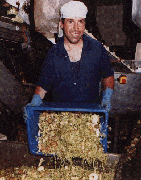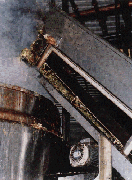Cleaner Production Pays Dividends
Banksia Food Products Pty. Ltd.
Banksia Food Products found a way to convert wastage into
profits. By implementing recommended cleaner production measures, the company
has been able to dramatically increase productivity and minimise wastage.
Background
Banksia Food Products Pty. Ltd., located in the Sydney suburb of Moorebank,
employs over 30 people and has an annual turnover of $3 million.
The company processes and packages apples for the baking and catering industry, with fresh product being delivered daily to bakeries.
The Process
The Banksia production process requires a substantial amount of clean
water for washing apples, and for daily cleansing of conveyers, processing plants
and floor areas.
A considerable amount of solid waste is generated in the process, consisting of apple cores, and peelings and floor contaminated product, much of it caused by old equipment.
After apples have been peeled, cored and diced, they are blanched in steam heated jacketed tanks. In the blanching process, excess juice is extracted. Prior to the cleaner production initiatives, the juice was discharged through the floor drains with other effluent into the sewer.
Cleaner Production Initiative
Recognising that sizeable potential earnings were being lost through wastage and other inefficiencies, an independent environment management diagnostic investigation was commissioned to review water use, and examine reuse, re-cycling and treatment options.

Factory waste
Financial assistance of $4,000 was provided by the then National Industry Extension Service (NIES), with the company being required to contribute only $1,000.
The diagnostic identified significant features of the plant needing to be addressed.
- a large portion of apples was being wasted on the floor at every stage of
operation due to plant layout and the inability of materials handling facilities
to cope with the smooth flow of products. In particular, the existing conveyor
and dicer was poorly designed and needed replacing.
- Excess juice, rich in sugar and fine apple particles, was being discharged
into the sewer.
Waste being carried by conveyor
Advantages of the Process
As a result of the diagnostic recommendations:
- excess juice is being concentrated, together with peelings and cores, for
use as a sugar supplement in sauces and jams. Annual returns from this measure
are between $6,000 to $10,000.
- cardboard and other waste packaging is baled and removed free for recycling.
It previously cost $3,000 to $4,000 to have packaging removed with general
rubbish.
- a new enclosed conveyor and dicer has been installed, reducing product losses
and cleaning requirements.
The company is enthusiastic about the diagnostic report and is using it as its "working program for the future". Implementation of the measures recommended has given rise to immediate cost reductions.
In 1995, the company achieved a product yield greater than 3 percent, in addition to the savings from significantly reduced water and effluent charges.
Banksia invested approximately $200,000 in 1995 to achieve its cleaner production goals. Payback will be achieved in 5 years (by the year 2000).
It has since embarked on a waste stream project in association with the University of Western Sydney. The project aims to identify a range of as yet untapped earnings possibilities. A particularly promising application involves the recovery of wet peel for conversion to powder for use in baking, confectionery and as a pectin replacement.
The company is also looking at a continuous automated process to eliminate inconsistency in production.
Cleaner Production Incentive
The diagnostic investigation was largely triggered by high water and
trade waste charges, and the realisation that potential profit was being lost
through process practices and wastage.
Banksia Food Products is now using the cleaner production process to identify further efficiencies and savings, including lagging of steam pipes to save energy; seeking better electricity and gas rates; and more efficient labelling and purchasing processes.
The company has become more analytical and questioning in its management approach as a result of the process.
Barriers
The most important constraint on Banksia Food Products, as a small
manufacturing company, was the time and resources (including financial) required
to put the initiatives into place.
It was especially difficult to break into production processes to install equipment or make process changes. Installation and testing had to be carried out outside working hours and over weekends.
Contact
Mr Monty Williams
Managing Director
Banksia Food Products Pty. Ltd.
7 Helles Avenue
Moorebank
NEW SOUTH WALES 2170
Ph: 61 2 9600 6299
Fax: 61 2 9821 4168
Case study coordinated by the Environment Management Industry Association of Australia (EMIAA), April 1998.

The Cleaner Production Case Studies Directory is part of EnviroNET Australia.
- For more information contact:
 Environment Australia
Environment Australia
Environment Protection Group
PO Box E305
KINGSTON ACT 2604
AUSTRALIA
Email: cproduction@ea.gov.au
URL: http://www.environment.gov.au/net/environet.html

